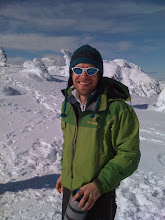Sen. Ted Stevens gave his annual address to the state legislature today, and he spent a good chunk of time talking about UAF's Katey Walter and her research on the release of methane from Alaska lakes and ponds. He called her "one of Alaska's brightest young scientists" and gave a synopsis of her research and his idea.
Methane is bubbling up out of lakes -- potentially faster now as permafrost thaws with warming temps -- and into the atmosphere, where it has a strong greenhouse gas effect, he said. If the state and the feds can assess the supply and figure out how to use it, they could address climate change and high rural energy costs at the same time.
After his address, Stevens took questions from the press in the House Speaker's office. He sat on the table like he always does, and he had Walter sit next to him.
Walter said there's a tremendous amount of methane already coming out of lakes, and gas hydrates and natural gas on top of that. She explained that farmers in the Netherlands were already using methane in groundwater by bringing it to the surface and separating out the water with a low-tech, sprinkler-type system. The sprinklers are topped with heavy caps that "naturally" pressurize the gas enough to pipe it into homes, where it can be used for heating and cooking.
"They don't pay heating bills," she said.
Stevens said he's already asked high-ups in the Bush administration about having NASA do spectral analysis of methane hotspots by satellite, or aerial surveys at least. The state could chip in to test the feasibility of the gas as an energy source, he added.
When someone asked why the state hadn't looked into this before, Stevens said no one even knew about leaking methane before Walter's research. "She discovered it."
(I wrote a bit about her research in November.)
He said Walter is working on a pilot project to heat homes in one place and possibly generate power in another.
She said the technological trick will be figuring out a way to harness the gas bubbling up from lakes rather than the gas contained in subsurface pools.
The whole thing amounted to an impressive endorsement of Walter's research -- Stevens had little flyers Walter wrote distributed to every legislator -- that pretty much came out of the blue.
It left me and the other reporters a little befuzzled. How big a deal is this? How new is it? And how does lake methane relate to coal-bed methane? (Or natural gas, I might add, which is mostly methane.)
Stevens presented Walter's idea as something of a panecea -- a solution to the rural energy crisis that's doubly good for climate change. Capturing and burning the gas would replace another (potentially carbon-heavy fuel source), and it would release carbon dioxide to the air rather than methane, which has the stronger greenhouse gas effect.
Walter made that last point about how burning the gas was actually better (in terms of climate change) than letting it escape, but I'm skeptical without knowing how much CO2 you'd get from a given amount of methane.
In any case, Go Katey!
Subscribe to:
Post Comments (Atom)

1 comment:
Hey Stefan,
So I guess this is why you're a journalist and i'm a scientist... I had no idea that last month Katey sat at the right hand of, er, ... Stevens. I do know however that one molecule of methane combusts with two molecules of oxygen from air to produce one molecule of carbon dioxide and two of water. I.e. one part potent GHG to one part less potent GHG plus two parts stuff of life... pretty clean deal...
Post a Comment